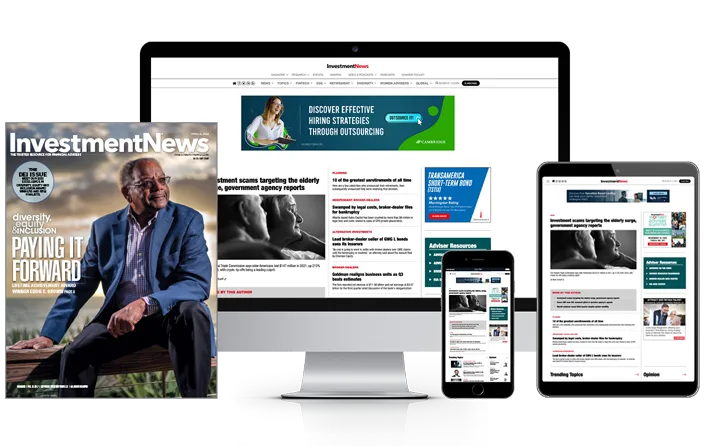

Digital advice platforms have dealt with market volatility before, but nothing quite like the recent activity driven by fears of the spreading coronavirus.
The final week of February brought about the market's worst performance in over a decade, before robo-advisers even existed. So how did they do?
The good news is the two most popular start-ups, Betterment and Wealthfront, stayed online, which is more than can be said for some of the popular online brokerage platforms for do-it-yourself investors. Both services had crashed in February 2018, when the S&P 500 Index sank 4.1%.
Wealthfront vice president of communications Kate Wauck said new investment account signups were “through the roof high” during the market volatility.
Betterment senior communications manager Arielle Sobel said it has seen more "dip buying" than any other client reaction. Some clients moved toward cash and lower-risk allocations, but nothing extreme, Ms. Sobel said.
Overall, Betterment saw more inflows than outflows, and most inbound calls were about tax-loss harvesting and how to do more of it, she added.
Researchers at Backend Benchmarking, which opens portfolios at leading robo-advisers to track their performance, said most portfolios managed by a digital adviser performed similarly through the market swings.
Portfolios managed by TD Ameritrade’s Essential Portfolios stood out for capturing more of the market upside than downside so far in 2020, said David Goldstone, head of research at Backend Benchmarking.
“Within fixed income, they are concentrated in investment-grade fixed income, which helped balance falling equity prices,” Mr. Goldstone said in an email.
TD did not comment by publication time.
Charles Schwab’s Intelligent Portfolios captured more of the market’s year-to-date downside than upside, which Mr. Goldstone attributed to Schwab’s higher-than-average exposure to international equities, small exposure to high-yield and international fixed income, and high cash allocation.
Schwab did not respond to a request for comment.
However, Intelligent Portfolios was one of the few robos — along with Wealthfront, Axos Invest and US Bank — to conduct significant tax-loss harvesting over the last week, Mr. Goldstone said.
Because robo-advisers are meant for long-term investing and implement mostly low-cost, passive investing strategies, Mr. Goldstone said he wouldn’t expect to see much other activity aside from rebalancing trades and tax-loss harvesting.
"As markets fall, we would also expect that rebalancing trades will start to appear, selling equities and buying fixed income to maintain target allocations,” he said. “So far we have seen minimal rebalancing trades as a result of last week's market volatility. Managers may be waiting for volatility to die down before executing rebalancing trades.”
“Generally, given the events last week, I find that the lack of tax-loss harvesting in many of our accounts is unimpressive,” he added.
Mr. Goldstone commended digital advisers for increased client communications during the volatility that tried to downplay concerns about long-term economic impacts from the coronavirus while encouraging investors to stay the course.
“Most major robo-advice providers are proactively emailing clients to keep them informed and calm," he said.

The looming threat of federal funding cuts to state and local governments has lawmakers weighing a levy that was phased out in 1981.

The fintech firms' new tools and integrations address pain points in overseeing investment lineups, account monitoring, and more.

Canadian stocks are on a roll in 2025 as the country prepares to name a new Prime Minister.

Carson is expanding one of its relationships in Florida while Lido Advisors adds an $870 million practice in Silicon Valley.

The approval of the pay proposal, which handsomely compensates its CEO and president, bolsters claims that big payouts are a must in the war to retain leadership.
RIAs face rising regulatory pressure in 2025. Forward-looking firms are responding with embedded technology, not more paperwork.
As inheritances are set to reshape client portfolios and next-gen heirs demand digital-first experiences, firms are retooling their wealth tech stacks and succession models in real time.
